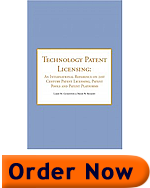[Summary of Chapter 4]:
The concepts of “fair” and “reasonable” in FRAND mean almost nothing unless they are defined in a concrete way. Chapter 4 describes a specific process by which “fair” and “reasonable” may be determined. Ten key concepts related to value are presented and defined. The three legal documents used to set up a licensing program are explained.
=\=\=\=\=\=\=\=\=\=\=\=\=\=\=\=\=\
[Brief Excerpt from Chapter 4, pp.142-143 and 144-145]:
A patent that is “essential” to the standard is, by definition, one that cannot be designed around [by an infringer, who]…is required to either take a license from the holder of the essential patent, choose not to enter the market at all, or choose to violate the patent at the risk of serious money damages and an injunction that could shut down the business. The kind of supply and demand considerations in licensing unpatented rights, cannot apply in a case where a standards body has created a technical standard and the patent is essential to the implementation of the standard…In a free market, supply and demand match to create the market clearing price. But the free market system of pricing does not work with the licensing of patents that are essential to a technical standard…Overall…, the goal is to achieve a market clearing price in the absence of market forces. In that way, there will be real content to the term FRAND/RAND, licensors will be fairly compensated, and licensees will receive licenses to essential patents on terms which will allow the licensees’ participation in the market.
To Continue to Chapter 5 –Click Here.
